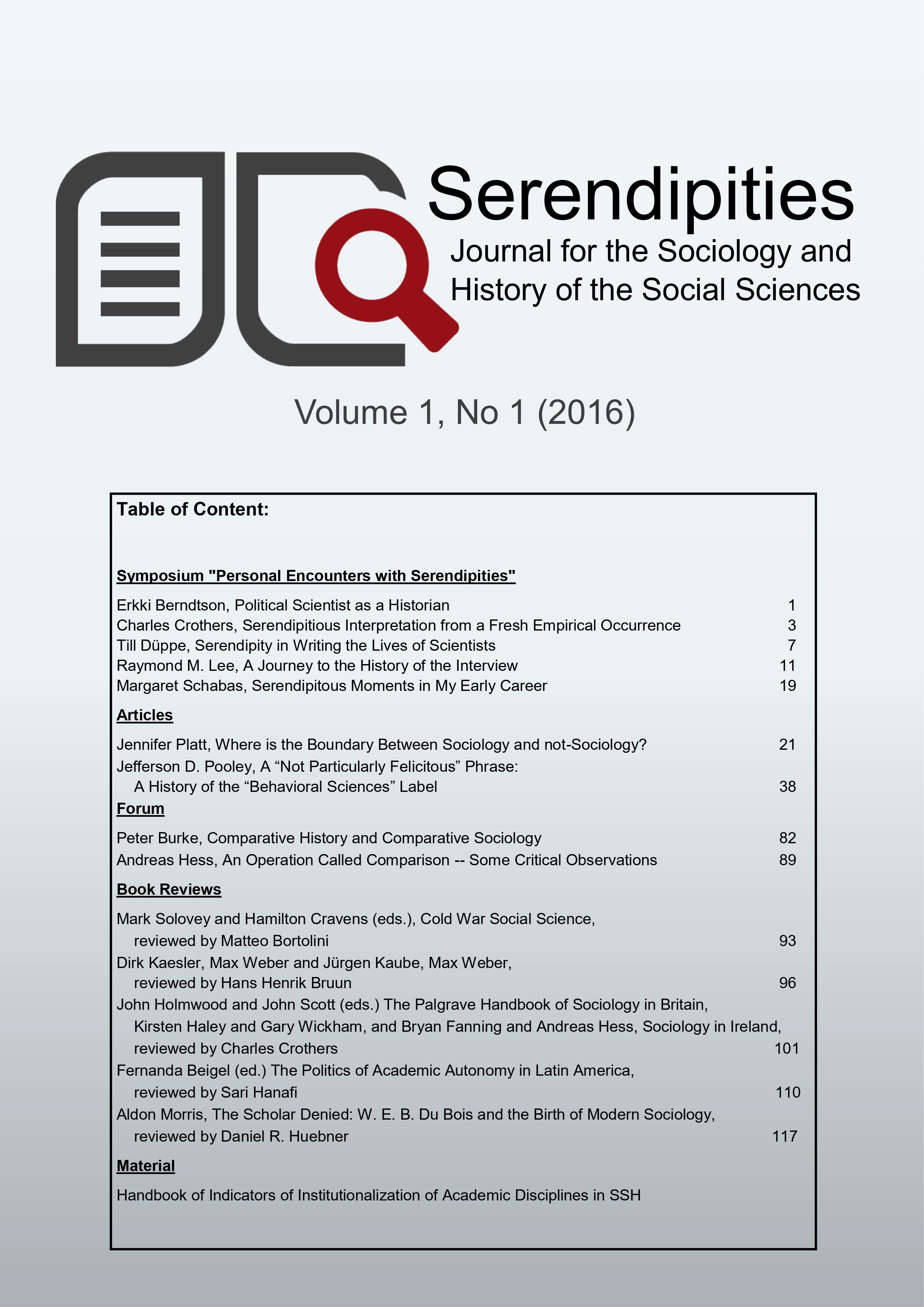Where is the Boundary Between Sociology and Not-Sociology?
DOI:
https://doi.org/10.7146/serendipities.v1i1.122861Keywords:
Boundaries between disciplines, Sociology, Definition ofAbstract
In work on the history of sociology, how may the boundaries of study be defined, and what requires explanation as part of sociology? Becker’s concept of the „art world’ suggests thinking in terms of the „sociology world’ which is needed to produce the sociological object. Three very different examples – Young and Willmott’s Family and Kinship in East London, a cross-disciplinary quantitative sociology study group, and Hodson’s use of amateur descriptions of workplaces as data – are discussed, and it is concluded that the practical methodological answer depends on the particular research topic and the resources available.
References
Barbour, Roger (2010) Other Lives: Philip Barbour, The Guardian, Aug. 2.
Becker, Howard S. (2008) Art Worlds, Berkeley, University of California Press.
Benney, Mark (1966) Almost a Gentleman, London: Peter Davies.
Benney, Mark, A. P. Gray and R. H. Pear (1956) How People Vote: A study of electoral behaviour in Greenwich, London: Routledge and Kegan Paul.
Bott, Elizabeth (1957) Family and Social Network, London: Tavistock.
Briggs, Asa (2001) Michael Young: Social Entrepreneur, Houndmills: Palgrave.
Chapoulie, Jean-Michel (2009) A Framework for the History of Social and Behavioral Sciences, Sociologica 2/3.
Ennis, James G. (1992) The Social Organization of Sociological Knowledge: Modelling the Intersection of Specialties, American Sociological Review 57: 259-265.
Firth, Raymond ed. (1956) Two Studies of Kinship in London, London: Athlone Press.
Glass, David V. (1954) Social Mobility in Britain, London: Routledge and Kegan Paul.
Glass, Ruth (1939) Watling: A Survey of Social Life on a New Housing Estate, London: P. S. King.
Glass, Ruth and Maureen Frenkel (1946) A Profile of Bethnal Green, London: Association for Planning and Regional Reconstruction.
Jephcott, Pearl, Nancy Seear and John H. Smith (1962) Married Women Working, London: Allen and Unwin.
Katz, Elihu and Paul F. Lazarsfeld (1955) Personal Influence, Glencoe: Free Press.
Kerr, Madeline (1958) The People of Ship Street, London: Routledge and Kegan Paul.
Laing, Stuart (1986) Representations of Working Class Life 1957-1964, London: Macmillan.
Mandeville, John P. (1946) Improvements in Methods of Census and Survey Analysis, Journal of the Royal Statistical Society 109 (2): 111-129.
Marshall, T. H. (1973) An Appreciation: Richard Titmuss, British Journal of Sociology 24: 137-139.
Mayer, Karl Ulrich, John H. Goldthorpe and Stein Ringen (1985) Editorial Foreword, European Sociological Review 1: i-ii.
Monchaux, Cecily de and Gertrude H. Keir (1961) British Psychology 1945-1957, Acta Psychologica 18: 120-166.
Moser, Claus (1958) Survey Methods in Social Investigation, London: Heinemann.
Platt, Jennifer (1971) Social Research in Bethnal Green, London: Macmillan.
Platt, Jennifer (1976) Realities of Social Research, London: Sussex University Press.
Platt, Jennifer (2009) Comment on Jean-Michel Chapoulie, Sociologica 2-3.
Platt, Jennifer (2013) What Have We Done, and What Remains to Be Done, In the History of Sociology?, Sartoniana 26: 115-140.
Platt, Jennifer (2014) The International Library of Sociology and Social Reconstruction and British Sociology, in: John Holmwood and John Scott (eds.), The Palgrave Handbook of Sociology in Britain, 236-259, Palgrave Macmillan.
Platt, Jennifer, Charles Crothers and Mervyn Horgan (2013), Producing Ethnographies: Workplace Ethnographies in History, Journal for the History of the Behavioral Sciences 49: 1-18.
Robb, James H. (1954) Working-Class Anti-Semite, London: Tavistock.
Saville, John (1957) Rural Depopulation in England and Wales 1851-1951, London: Routledge and Kegan Paul.
Sheldon, J. H. (1948) The Social Medicine of Old Age: Report of an Inquiry in Wolverhampton, Cambridge: Cambridge University Press.
Shils, Edward (2006) A Fragment of a Sociological Autobiography, New Brunswick: Transaction.
Shils, Edward and Michael Young (1953) The Meaning of the Coronation, Sociological Review 1: 63-81.
Simonson, Peter (ed.) (2006) Politics, Social Networks, and the History of Mass Communications Research: Re-Reading Personal Influence, Thousand Oaks, CA: Sage.
Sinclair, Susan (1979) John C. Spencer, 1915-1978, British Journal of Criminology 19:1-2.
Spinley, B. M. (1953) The Deprived and the Privileged: Personality Development in English Society, London: Routledge and Kegan Paul.
Steinmetz, George (2013) A Child of the Empire: British Sociology and Colonialism, 1940s-1960s, Journal of the History of the Behavioral Sciences 49(4): 353-378.
Thompson, John B. (2005) Books in the Digital Age, Cambridge: Polity Press.
Topalov, Christian (2003) Traditional Working-class Neighbourhoods, Osiris 18: 212-233.
Wilkins, Leslie T. (1999) Unofficial Aspects of a Life in Policy Research, Cambridge: privately published.
Williams, W. M. (1963) A West Country Village: Ashworthy, London: Routledge and Kegan Paul.
Willmott, Peter (1985) The Institute of Community Studies, in: Martin Bulmer (ed.), Essays on the History of British Sociological Research, 137-150, Cambridge: Cambridge University Press.
Young, Michael (2000) Obituary, Peter Willmott, The Guardian, April 19: 24.
Young, Michael, interviewed by Paul Thompson (2004) Reflections on researching Family and Kinship in East London, International Journal of Social Research Methodology 7: 35-44.
Young, Michael and Peter Willmott (1957) Family and Kinship in East London, London: Routledge and Kegan Paul.
Young, Michael and Peter Willmott (1961) Research report No. 3: Institute of Community Studies, Bethnal Green, Sociological Review 9: 203-213.
Downloads
Published
How to Cite
Issue
Section
License
CC-BY-NC-ND





